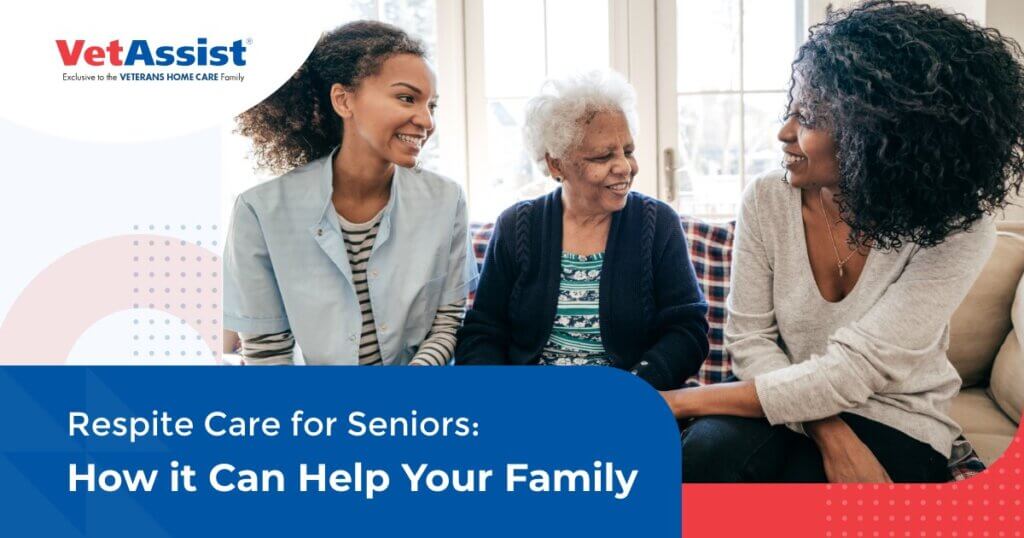How Respite Care for Seniors Can Help Your Family
According to the Caregiving in the US 2020 report, about 42 million Americans are providing unpaid care for a relative or friend aged 50 or older—an increase of about 8 million from 2015. This stunning statistic represents immense care and compassion, but also difficult, exhausting labor that no one should have to undertake alone. This is where senior respite care comes in as a valuable resource.
The purpose of respite care is to provide a much-needed break for spouses, children, other family members, and friends who give so much to support their loved ones’ health, safety, and quality of life. Over 6 in 10 caregivers of seniors are employed elsewhere, meaning they provide unpaid care in addition to working a part- or full-time job. The average age of these caregivers is 69 years old, and roughly a quarter care for more than one adult. These factors plus the challenges faced by their loved ones—mobility issues, dementia, vision and hearing loss, substantial medication regimens, and chronic illness, to name a few—create conditions easily conducive to exhaustion and compromised health, as well as compassion fatigue and isolation.
A respite caregiver plays a vital role in sustaining families so that they can care for their loved one at home while maintaining their own physical, mental, and emotional health. In this way, the meaning of respite care goes well beyond a break of a few hours or days: it provides long term wellness and wellbeing to the whole family.
What Is Respite Care, and What Does It Entail?
The definition of respite is a short relief, and that is the basic idea behind respite care. It provides the opportunity for caregivers to rest, run errands, connect with friends, and to generally take care of themselves. Anyone who has poured into someone else long enough will realize they have nothing left to pour if they don’t refill themselves every so often; a respite caregiver allows peace of mind while the hardworking spouse or child attends to other matters or to their own needs.
Most caregivers spend much of the day helping their loved one with the Activities of Daily Life (ADLs, for short). These include helping them dress, bathe, eat, toilet, and move around the home. Assisting and supervising these activities is time consuming and can be further exacerbated by their loved one’s limited abilities or awareness. Respite home care services can provide a much-needed break for the caregiver to work uninterrupted, go to personal appointments, or just take a well-deserved nap without fear for their loved one’s safety or
wellbeing.
Who Provides Respite Care?
In-home respite care may be provided by trained, licensed caregivers who are not medical professionals, but who are focused on providing companionship, assistance with ADLs, and the comfort that a capable professional is at hand should your loved one be in any distress or danger. This person may also help with light household chores like laundry or grocery shopping.
Healthcare professionals such as nurses can also provide respite care when the senior requires medical supervision or medication administered.
Respite care outside the home can also be arranged via adult day care centers, where seniors can socialize with others and take part in planned activities supervised by the staff. Overnight care for a night, a week, or longer can also be a resource for caregivers traveling for business or on vacation.
What Are the Benefits of Respite Care?
Caring for another person can be physically and emotionally draining. When the caregiver doesn’t take the time to rest and recharge their batteries, they run the risk of burnout. Caregivers often feel guilty for their exhaustion, frustration, or even grief, but it’s perfectly
natural to feel the toll of caring for another person for all or most of the day, every day. It is vital to seek respite so that these emotions don’t intensify into health or relationship problems.
Having entrusted care of your precious loved one for a few hours, it’s important to disconnect from your responsibilities and make space to care for yourself. How you use the time is up to you: rediscover a favorite hobby, take a long walk, journal, get a haircut, go out with a friend, or simply attack your to-do list of items that will make you feel accomplished. What counts is that
you choose how you spend that time to recharge.
There are significant benefits to the senior being cared for, as well. First, they have a new person (or new people) to socialize with, which keeps them interested and engaged socially. Especially in cases where the senior has limited ability to leave home, this opportunity can boost their mood and quality of life. Second—and particularly in the case of respite care outside the home—there is the opportunity for the stimulus of a new space; a change of scenery or routine can also lift spirits.
In addition, a respite caregiver can be a strong emotional support to both the caregiver and the cared-for senior. They are tried and trained, compassionate professionals with helpful perspectives to offer on the challenges that can make both the carer and cared-for feel alone. Their presence can bring relief in ways beyond the tangible.
How Can I Get Respite Care?
While some caregivers pay privately for respite care, some insurance and disability plans help cover the cost.
For US armed forces veterans and their families, the VA offers benefits to those who meet certain qualifications, which may assist with access to respite care.
If your loved one needs home care, our VetAssist mission is to make home care easily and quickly accessible for those who qualify through the VA Pension with Aid and Attendance benefit. Veterans Home Care can help you determine whether you or your loved one will be eligible to receive the benefit, which can cover some or all of the cost of home care, and we make it easy to apply. Chat with us via our website, or call us at (888) 314-6075.
By Sylvia Trein, staff writer















